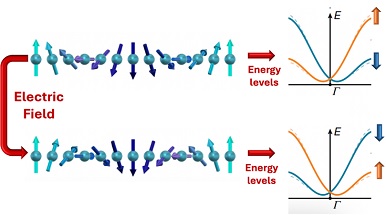
Traditional theories of magnetism distinguish between ferromagnetic materials (such as those used to make fridge-magnets) – in which the spins of electrons align to produce a net magnetization below a critical temperature – and antiferromagnetic materials, where the spins of neighboring sites are aligned in opposite directions, resulting in a zero net magnetization. Ferromagnets are ideal for applications in spintronics (electronics based on electron spin), but they are susceptible to unwanted "parasitic" magnetic fields that limit device efficiency and speed. In contrast, antiferromagnets are immune to such parasitic fields but suffer from the drawback of being difficult to manipulate with external magnetic fields due to their lack of net magnetization.
Materials that could combine “the best of both worlds” became available around 2022 with the discovery of the so-called “third state of magnetism”: altermagnetism. In altermagnets, electronic states with spins in one direction have different energy than those with opposite spin, despite the material having zero net magnetization. Due to its high potential impact, particularly in technology, the discovery of altermagnetism was included—the sole topic within the whole field of physics—in Science’s list of the “Top Scientific Discoveries of 2024”.
A research team from the Department of Materials Science at the University of Milano-Bicocca, led by Prof. Silvia Picozzi, in collaboration with Prof. Riccardo Comin of the Massachusetts Institute of Technology (MIT) in Boston, has identified a new and promising altermagnetic material, nickel iodide (NiI2). The discovery, published in the prestigious journal Nature (Impact Factor 48.5, 2024 Journal Impact Factor, Journal Citation Reports, Clarivate Analytics, 2025), in the article titled
“Electrical switching of a p-wave magnet” (doi: s41586-025-09034-7), lays the foundation for a new class of materials that could enable spintronic devices with ultra-low power consumption and extremely high operational speed. For instance, spintronic RAM has demonstrated energy savings exceeding 95% compared to conventional CMOS devices. It's worth noting that data centers already account for over 2% of the world's total energy consumption.
In this project, the UNIMIB team focused on theoretical modeling and computational analysis, while the MIT group carried out the experimental characterization, both physical and functional. Although NiI2 serves as a fundamental model system for deepening our understanding of altermagnetic materials, it is not yet ready for practical device implementation due to its low magnetic transition temperature. The next step will be to design a material that maintains the same desirable properties at room temperature, building on the knowledge gained from NiI2.